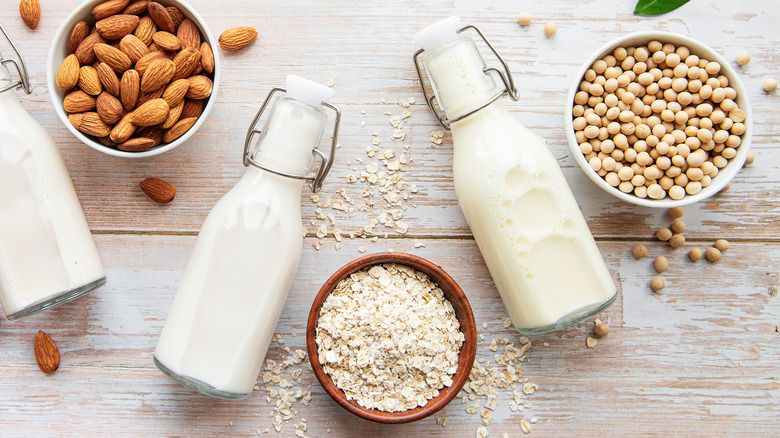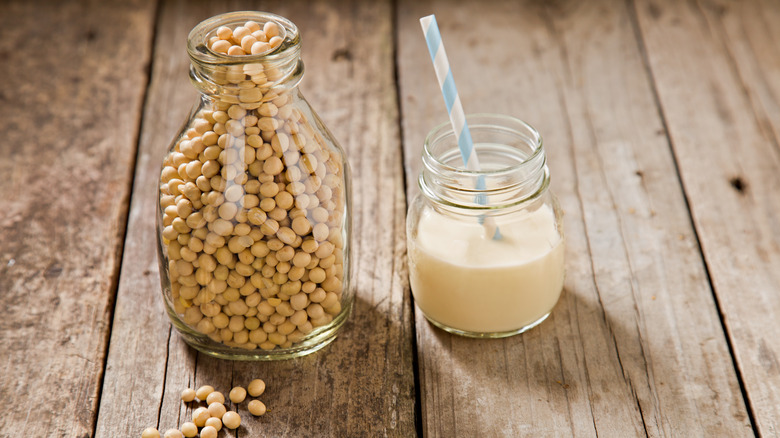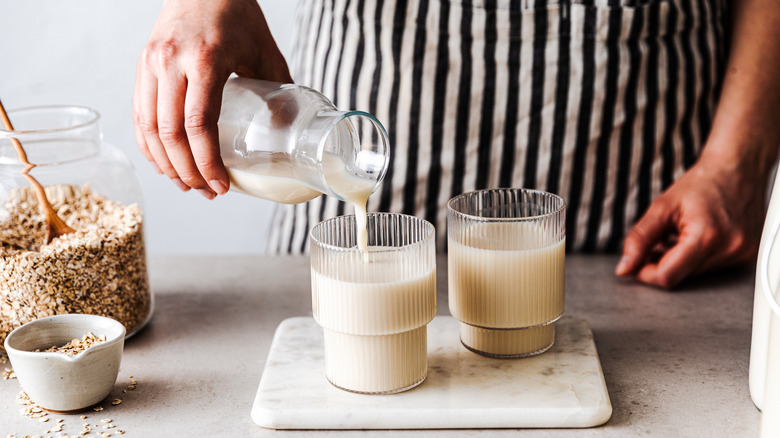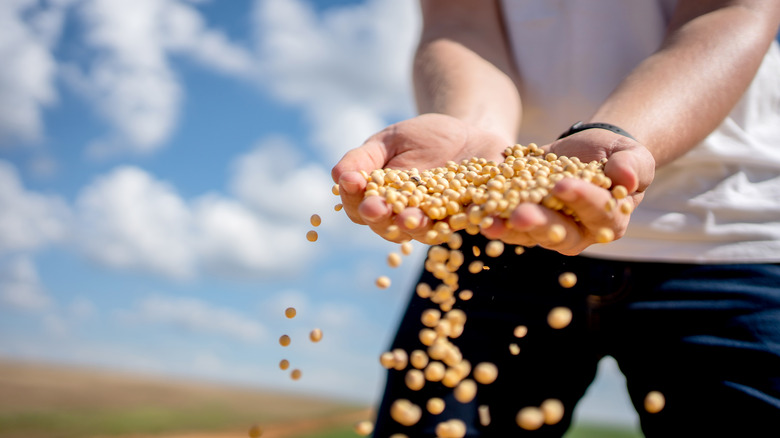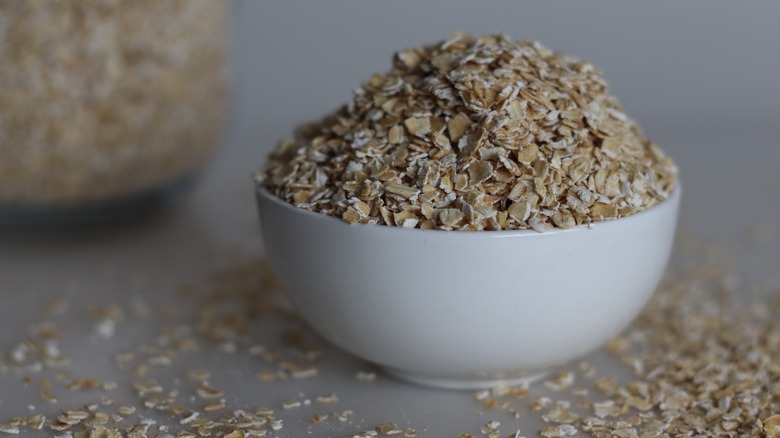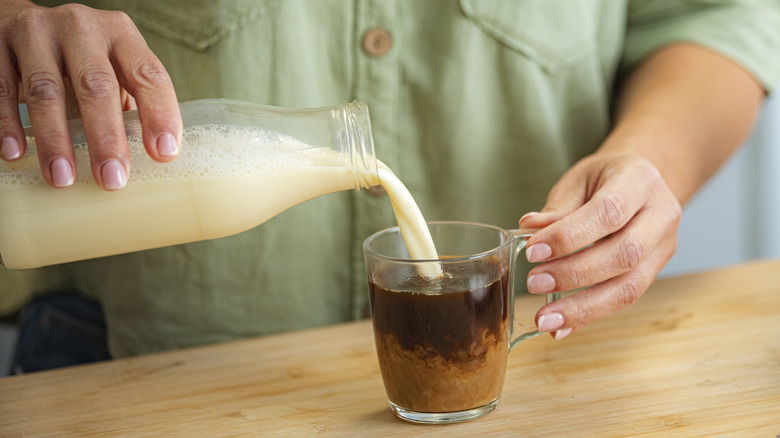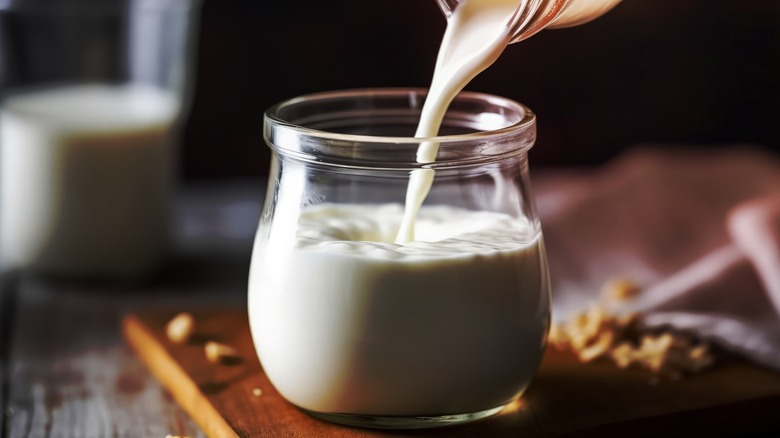Oat Milk Vs Soy Milk: What's The Difference?
The popularity of non-dairy milk has been growing in recent years. Oat milk and soy milk are two of the most popular options on the market. Perhaps you're wondering which is better in terms of nutrition or flavor, or maybe you just want to understand more about these milks. Either way, this article will compare the two so you can learn the difference between oat milk and soy milk and make an informed decision about which to buy.
Oat milk, crafted from old-fashioned rolled oats, has gained considerable traction in recent years due to its creamy texture and mild, naturally sweet flavor. However, there's more to it than that. We want to delve into the specifics to comprehend how it stands against its soy counterpart. Then we have soy milk, a pioneer in the realm of plant-based dairy alternatives. Derived from soybeans, soy milk boasts a higher protein content. Beyond its nutritional profile, soy milk has been a staple in various cultures for centuries, so it's an old favorite when it comes to non-dairy milk.
As we explore oat milk versus soy milk, we'll look at the differences in taste, nutritional value, environmental impact, and more. It might just help you decide which is the right choice for you. Either way, you're sure to learn something new.
Soy milk has a much longer history
Soy milk has a rich history, dating back to 14th-century China. Oat milk, on the other hand, was only invented in the 1990s. So, as you can see, soy milk has a far longer history. But let's look at them in a little more detail.
We'll start with soy milk. Its first mention is in a Chinese document called "Yiya Yiyi" by Han Yi which scholars estimate was published in 1365. It mentions soy milk, using the name doufujiang for it. By the 1600s, it's likely that soy milk was used extensively in China. Its first mention in English was in "A Collection of Voyages and Travels" by Domingo Fernandez Navarrete from 1704. But if we're talking about the commercial production of soy milk, it began in the early 1900s. By 1917, it was produced commercially in the U.S. by a company called J.A. Chard Soy Product.
Oat milk has a much shorter history. Rickard Öste, a food scientist from Sweden, was one of the first people known to make oat milk, which he concocted in the 1990s. Öste was doing research into sustainable food production and lactose intolerance when he invented the drink. He later co-founded the oat milk brand Oatly, which is still one of the most popular brands on the market today.
Oat milk is slightly easier to make
The process for making soy milk (whether commercially or at home) is slightly more complicated because the soybeans need to be cooked before blending, whereas oats just need soaking. Oat milk starts with whole oat grains. The oats are soaked in water to soften them, making them easier to blend. The soaked oats are blended with water. This blend is what forms the base of oat milk. The oat-water mixture is then strained to separate the liquid from the solid oat residue. Some commercial oat milk products may undergo additional steps to adjust sweetness and flavor. This can include adding sweeteners, salt, or natural flavorings to enhance the taste. For improved nutritional value, oat milk is often fortified with vitamins and minerals such as calcium, vitamin D, and vitamin B12.
The soy milk making process starts with soybeans being steamed, split in half, and de-hulled. The beans are then cooked, which destroys an enzyme that makes them indigestible to humans. These cooked beans are then ground — first roughly and then more finely. This creates a slurry, which is essentially soy milk with some finely ground particles left in. The next step is to remove the particles from the soy milk. During the commercial process, this is done in a centrifuge, but those making soy milk at home will simply strain it. As with oat milk, some commercial manufacturers will then sweeten and fortify the soy milk.
Soy milk contains more protein
Soy milk boasts approximately 7 grams of protein content per cup. By contrast, oat milk tends to provide around 3 grams of protein per cup. This can vary a little between brands. However, it's still a considerable difference and is worth noting if you're trying to make sure you get enough protein in your diet. (Soy milk is made from beans, which are known for their high protein content, and that makes a difference.)
Protein plays a pivotal role in various physiological functions within the human body. It serves as a fundamental building block for tissues, muscles, enzymes, and hormones. The amino acids derived from protein are crucial for the repair and regeneration of cells, making it an essential nutrient for overall growth and maintenance. Additionally, protein aids in the development and maintenance of muscle mass, supports immune function, and contributes to the feeling of satiety, potentially assisting in weight management.
For vegans, vegetarians, or anyone who eats a heavily plant-based diet, obtaining sufficient protein can be a concern, as traditional animal-based sources are excluded. This makes soy milk an especially valuable option for those looking to meet their protein needs while adhering to a plant-based diet. However, it's crucial to note that protein requirements vary among individuals based on factors such as age, activity level, and health status. While soy milk provides a substantial, plant-based protein boost, oat milk offers other nutritional advantages, such as a higher fiber content.
Oat milk contains more fiber
Oat milk is notably richer in dietary fiber than soy milk. Oat milk has approximately 2 grams of fiber per cup, while soy milk provides a comparatively modest 0.5 grams of fiber per cup. But what does this mean, and why does it matter?
Dietary fiber plays a pivotal role in maintaining a healthy digestive system. It aids in regular bowel movements, prevents constipation, and contributes to the overall well-functioning of the gastrointestinal tract. Moreover, fiber is recognized for its potential to help control blood sugar levels and regulate cholesterol levels.
The fiber content in oat milk is primarily attributed to the nature of whole oats, as the milk retains some of the natural oat bran and fiber during the production process. Despite its lower fiber content, soy milk offers its own set of nutritional advantages, particularly in terms of protein, as mentioned above. While soy milk might not match the fiber levels of oat milk, its commendable protein content is worth mentioning.
Ultimately, the choice between oat milk and soy milk is more than just a simple comparison of fiber content. It might be one factor worth considering — particularly if your diet lacks fiber — but it's certainly not the only reason to choose oat milk, nor is it a reason to shun soy milk.
Oat milk has a more neutral flavor
Taste matters when it comes to non-dairy milk. Oat milk is a fan favorite for its notably neutral flavor. Unlike soy milk, which can occasionally carry a faint beany undertone, the flavor of oat milk is known to be mild. Its neutral taste makes it an adaptable ingredient in various culinary applications, seamlessly integrating into both sweet and savory dishes without overpowering the overall flavor. It's also the reason why oat milk is popular with baristas — its flavor doesn't compete with the espresso in milky drinks.
The taste of soy milk can vary between brands, and some iterations retain a subtle beany essence that might not appeal to all palates. Additionally, sweetened soy milk can be hit or miss, as certain brands tend to veer towards an overly sweet and vanilla-centric profile. Some people like this, while others find it overpowering in tea or coffee. Plus, it's not as versatile for use in sweet and savory recipes. You'll always need to opt for unsweetened soy milk if you're making something savory.
Oat milk's neutrality in flavor means it doesn't bring pronounced or unexpected tastes to dishes. Its subtle, adaptable flavor profile adds a distinct appeal for those who want a genuinely versatile non-dairy milk.
Oat milk is less likely to curdle in coffee
Most soy milk drinkers have experienced pouring a dash of soy in their freshly brewed coffee, only to have it curdle. While it's safe to drink, nobody is particularly excited about drinking coffee with lots of little tofu-like lumps floating around in it. The great thing about oat milk is that it's less likely to curdle in coffee than soy milk. This is due to differences in their composition, specifically in how proteins and fats interact with the acidity of coffee.
Oat milk contains less protein than soy milk. Proteins in soy milk, particularly soy proteins, are more prone to coagulation or curdling when exposed to the acidity in coffee. The acidity can destabilize the proteins and cause them to clump together, leading to curdling. Oat milk, with its lower protein content, is less susceptible to this reaction. This is also why you might notice soy curdling in some coffees but not others — it's more likely to happen with acidic beans.
Oat milk also generally has a lower fat content compared to soy milk. Fats can contribute to curdling in coffee, especially when they interact with the acidity. The lower fat content in oat milk reduces the likelihood of curdling. While individual experiences may vary, oat milk is still far less likely to curdle in coffee, maintaining a smooth, creamy texture.
Soy milk has a thicker consistency
Although many people think of oat milk as the creamier option, soy milk has a much thicker consistency than standard oat milk. Now this doesn't mean that it's thick like cream or yogurt. It still has a liquid consistency that's suitable for use in any recipes that usually contain milk. It's just thicker and creamier than a lot of people realize.
For instance, if you pour the same amount of oat milk as soy milk into a cup of black tea, you might notice the oat milk barely changes the color of the tea, while the soy milk brings it to the perfect light brown hue. Oat milk can be quite watery, which leaves you without the creaminess that you want in some dishes. Soy milk gives you a creamier finish that's great in things like hot chocolate or rice pudding.
However, this is when we're comparing standard soy milk against standard oat milk. You can also buy barista oat milk or types of oat milk designed to replicate full-fat milk. These have a higher fat content, which results in a thicker and creamier milk. So, if you want to avoid thin, watery non-dairy milk, either opt for soy milk or barista-style oat milk.
You can curdle soy milk to use in baked goods
There's a neat trick you can do with soy milk to make it even more useful for baking. With its higher protein content, you can intentionally curdle soy milk by adding acidic ingredients like lemon juice or apple cider vinegar. This curdling process results in the formation of curds. The acid destabilizes the soy proteins, causing them to coagulate and separate from the liquid. But soy milk and oat milk respond differently when they are exposed to acidic ingredients, so the same can't be said for oat milk.
This curdled soy milk, enriched with the tanginess imparted by the acid, serves as an excellent replacement for buttermilk in baking recipes. The acidity contributes to the leavening process, producing light and airy baked goods. This versatility makes curdled soy milk a valuable ingredient for those seeking plant-based alternatives in traditional recipes.
Conversely, oat milk behaves differently when exposed to acidic components. Oat milk doesn't readily curdle in response to acidic ingredients. So, you can't use it to create a buttermilk alternative in the same way. Of course, this probably won't make much difference to you when choosing milk for everyday use. But, if you want to bake with non-dairy milk, soy milk has even more uses than oat.
Oat milk has a smaller carbon footprint
If you want to choose your milk based on its environmental impact, you should know that oat milk has a smaller carbon footprint than soy milk. The carbon footprint of 200 milliliters of oat milk is around 0.14 kilograms of CO2e, while the same amount of soy milk is responsible for 0.196 kilograms of CO2e. This isn't a huge difference, but it all adds up over time.
Plus, it's not just about the CO2 emissions, but also the land use and water use. It takes less land and less water to make oat milk than soy milk. It takes around 59.4 liters of water to make 200 milliliters of soy milk and 40 liters to make the same quantity of oat milk. It's worth mentioning that both oat milk and soy milk are significantly more eco-friendly than cow's milk.
It's important to note that sustainable agricultural practices, responsible sourcing, and efficient processing methods can significantly mitigate the environmental impact of both oat and soy milk. Additionally, the overall carbon footprint is subject to change based on factors such as the location of production, transportation methods, and the specific practices employed by individual brands.
Soy milk is a versatile choice for cooking savory dishes
Unsweetened soy milk is a remarkably versatile choice, particularly for those who prefer a more neutral and less sweet base for their dishes. Its inherently mild flavor means you can use it in savory recipes without imparting an overpowering sweetness. Whether used as a substitute for dairy milk in soups, sauces, or savory bakes, unsweetened soy milk maintains a delicate balance that complements various flavor profiles.
Plus, the versatility of unsweetened soy milk extends beyond savory applications. It proves to be an adaptable ingredient in sweet recipes as well, much like its dairy counterpart. From baking to desserts, unsweetened soy milk can be utilized without introducing an excess of sweetness.
On the other hand, oat milk's versatility in both sweet and savory recipes comes with a caveat. Some commercially available oat milk varieties tend to lean towards the sweeter side, potentially influencing the taste of savory dishes. This sweetness can be a desirable trait in certain recipes but might feel out of place in savory applications. Therefore the choice of oat milk for sweet or savory dishes becomes more of a case-by-case decision, requiring consideration of individual brand formulations and sweetness levels.
Unsweetened soy milk is a more straightforward and dependable option for those seeking plant-based milk to use in both sweet and savory dishes. Oat milk can sometimes work in sweet and savory dishes alike, but some brands are on the sweet side for savory use.
They both have pros and cons when it comes to steaming
Steaming plant-based milk for espresso drinks is both an art and a science, with soy and oat milk presenting their own unique challenges and advantages. Baristas often find themselves navigating the delicate balance between texture, flavor, and the ability to create beautiful latte art.
Soy milk has gained popularity among baristas for its ability to create creamy and stable foam suitable for crema flourishes. However, opinions vary, and some baristas encounter difficulties achieving the desired consistency. The taste of soy milk can be divisive; while some appreciate its subtle nuttiness, others find it overpowering or disagreeable. This taste variability contributes to the love-hate relationship some baristas have with soy milk.
Oat milk, especially in barista blends, is praised for its remarkable foaming capabilities. Many baristas find that it creates a velvety, stable microfoam, making it an excellent choice for latte art enthusiasts. Oat milk's flavor profile is subjective and varies widely. Some enjoy its naturally sweet, oaty notes, while others find it too distinct or overpowering. The flavor versatility can lead to varying preferences among baristas.
The term barista blend indicates that the oat milk is specifically formulated for use in coffee establishments, often with optimized ratios of ingredients, ensuring a smooth and consistent texture ideal for creating the desired foam for espresso-based drinks. If you use something other than a barista blend oat milk, it's unlikely to steam well.
Static Media owns and operates Mashed and Daily Meal.
